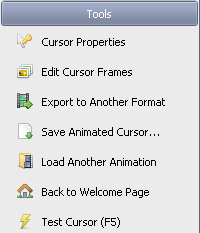- Open an existing animation file
Click this button to select an animated cursor (ANI), an animated GIF (GIF), a bitmap strip (BMP) or a video (AVI) file. If you select an animated cursor, AniTuner will open it and display the Properties page. Otherwise it will perform the conversion of the animation file. - Create a new animated cursor
This starts a blank animated cursor with default parameters: the Properties page is displayed and you can change settings like cursor size, number of colors and art information (author & title). A single blank frame is automatically added to the new cursor. Choose "Edit cursor frames" to import existing image files and create new frames for your animated cursor. - Browse for animated cursors
If you want to browse through all animated cursor files available on your computer, choose this option. A window similar to the Windows Open dialog box will be displayed, allowing you to navigate through your folders and select the .ani files you wish to see.
![]() Note: you can find animated cursors on your computer in the "Samples" subfolder of AniTuner, and in the "C:\Windows\Cursors" folder (or similar directory).
Note: you can find animated cursors on your computer in the "Samples" subfolder of AniTuner, and in the "C:\Windows\Cursors" folder (or similar directory).
How to navigate through the different options
![]() When an animated cursor is opened in AniTuner, three panels are displayed: Options & Help, Tools and Cursor Preview.
When an animated cursor is opened in AniTuner, three panels are displayed: Options & Help, Tools and Cursor Preview.
- The Tools panel lets you navigate through the different pages of AniTuner. This screenshot contains hot areas (this is a map image): click on the desired area to open the associated help topic.

- The Cursor Preview panel displays the animated cursor in live mode. You can of course resize this panel if the cursor does not fit the area.

![]() What is an animated cursor (important)
What is an animated cursor (important)